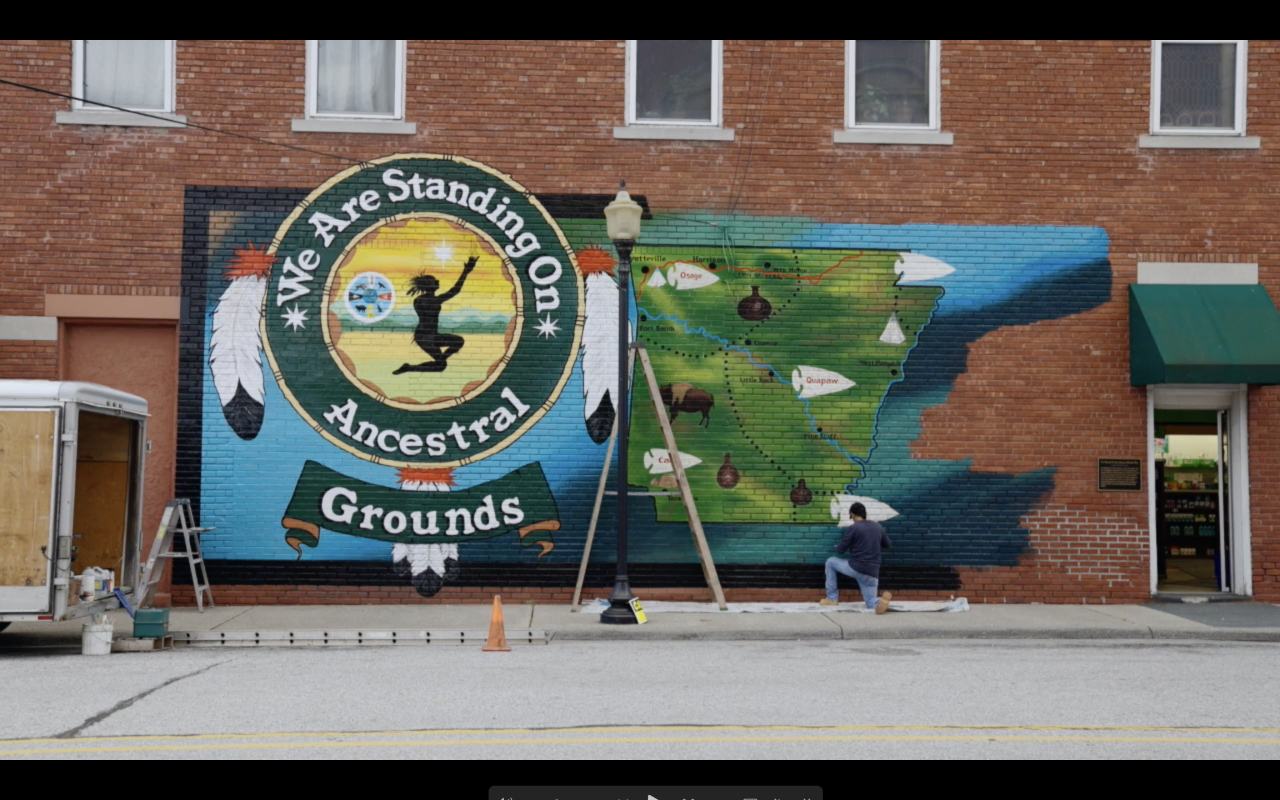A man kneels next to Sam Alexander Pharmacy in Harrison, Arkansas’ downtown business district. In his right hand, he has a painting easel as he uses his left hand to carefully paint the word “Tunica” between two bricks on the side of the building.
The man paints with a certain pride that scoffs at the verbal abuse he has received over his weeks working on the mural.
“I’ve seen people put the confederate flag up. I’ve heard people say, ‘Take that down. This is a racist mural,’” he said.
The man pauses to laugh to himself.
“It’s not. It’s an educational for the area Injuns that lived here before the white man took over,” he said.
Out of fear of retaliation, the man does not want to be named, but he is a native of Harrison, Arkansas, and one of the few residents who are not white.
Once you step back across the street the man’s mural comes into full context. It is a 20 ft. x 40 ft. painting of Arkansas with the words “We are standing on Ancestral Grounds.” Various parts of the state are marked with arrowheads to symbolize the various tribes that once called these parts of the state home.

“It makes me feel good,” says the man. “Being suppressed for years in here, it’s kind of like payback. I get to do something and show off my heritage. Something they’re not real proud of around here.”
Harrison is 94% white. It makes it one of the whitest towns in America. This man’s mural is one of several that has recently gone up around town to paint Harrison in a new light after living so many years with the moniker “The most racist town in America.”
“The reputation was much worse of our community than what we had understood in the community,” said Layne Ragsdale, a lifetime resident of Harrison.
What's it like to live in a place that is constantly followed by such an ominous shadow?
“It affects our business environment. It affects what kids our kids face when they go away to school. It affects what teams think when they come to our town to play," she said.
Just 15 miles north of Harrison is where the Knights of the Ku Klux Klan claims its headquarters. Over the years, it has attracted a subgroup of people to Harrison sympathetic to the Klan and its views.
As recently as six years ago, there were four billboards across town promoting white pride and denouncing anti-racism. This man’s mural is just one example of the art that has been used to replace their existence.
Today, there is only one billboard remaining. It promotes a white pride radio station that airs locally.
“There are some older folks, older generations that like things a certain way- to stay a certain way,” said Elizabeth Darden. “But I feel like the growth and different businesses coming into town I feel like they’re a lot more accepting of different backgrounds and cultures.”
Darden moved to Harrison nine years ago with her three mixed-race children. She has extended family that has lived here their entire lives, so she was well aware of its reputation before deciding to move here.
“I once had a fear to move here, but now, after seeing all the steps that they’ve taken to help erase the stains of hatred, I see this town becoming an awesome community. It already is an awesome community. We’re doing great things here,” she said.
Darden is one of the many that has taken an active role in erasing those “stains of hatred.” She, along Ragsdale and several others in the community, form the Harrison Community Task Force on Race Relations. Since 2002, the task force has worked to address Harrison’s lack of diversity and its dark past.
“I can tell you, without a doubt, that Harrison is not the most racist town in America,” said Kevin Cheri, a Black man that has lived in Northwest Arkansas for most of his life. “I think one of the things that makes Harrison special; it’s not its reputation, but actually, to me, it’s what people here are trying to do about it.”
In 2014, Cheri joined the Harrison Community Task Force on Race Relations as well. Since then, the task force has worked with the state’s Martin Luther King Foundation to bring its events during Martin Luther King week to the town of 13,000. Last year, Harrison held several BLM protests, and for several years, the task force has sponsored field trips for local students to visit predominantly Black communities all over Arkansas.
“People, I think, are often shocked when they come in here and see how openly we address and talk about issues of race because we’ve had to,” said Ragsdale. “And today, I think throughout the United States, most of white America is being forced into that conversation because it is so important, and we finally realized, as a country, how important it is.”
“Harrison cares,” said Cheri. “We care about an issue that is a national issue and we are just as concerned and interested to be involved in making change as anyone else.”
Harrison is a town of only 13,000 people, but it is proof of the progress that can come from a conversation that more than 330 million of us have been having.
Editor's note: this article has been updated to properly identify the name of the pharmacy with the mural as Sam Alexander Pharmacy





![SNG_Digital_Ad_480x360_CTA[13].jpg](https://ewscripps.brightspotcdn.com/86/a2/ba7c24d445c6bc7c85d9e749207a/sng-digital-ad-480x360-cta13.jpg)